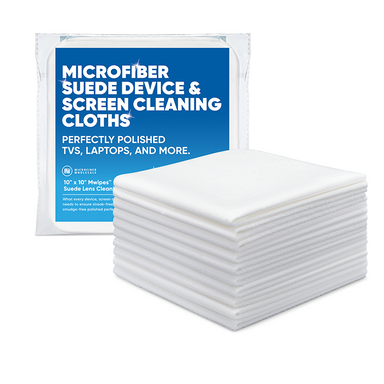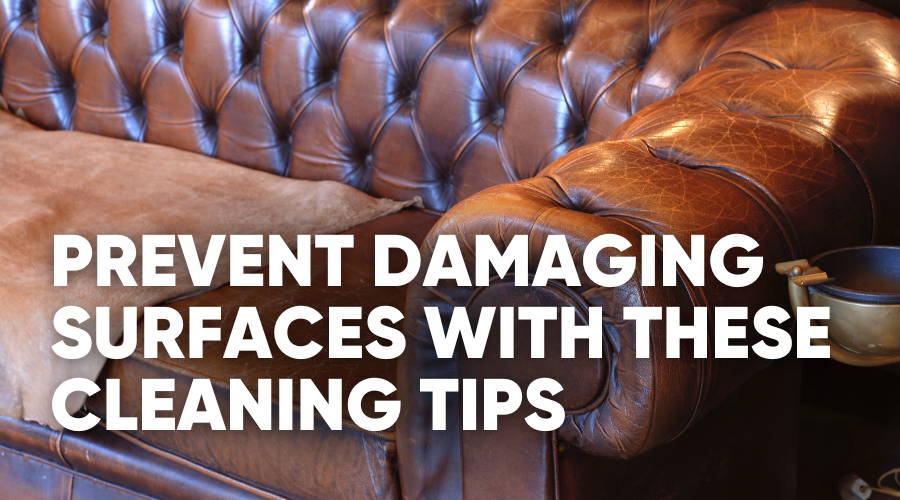Disclosure: This post may contain affiliate links.


Disclosure: This post may contain affiliate links.
If you've ever unintentionally damaged a surface while cleaning, you're not alone. From etched marble to scratched stainless steel, some materials require extra care to avoid mishaps.
Surfaces in a home don’t come with a warning label, so let’s talk about nine of the most common found in homes that need extra care when cleaning. And learn how to best clean these surfaces without causing any damage.
Do you remember schools 30+ years ago, when there were always several kids with peanut and gluten allergies? Yeah. Me neither.
Allergies have been on the rise for the past few decades. What’s surprising is, it’s partly due to the overuse of disinfectants and sanitizers. Basically, we’re too clean.
To simplify it, when we kill bacteria and germs with disinfectants, our immune systems don’t get exposed to any microbes (i.e, germs). Anyone with kids should know that in order for them to build up an immune system when they’re young, they need to get exposed to germs.
Now, nobody’s performing open-heart surgery in their living room (I hope). Yet some people clean like they are. They douse their floors and countertops with bleach frequently to kill anything that could, well, kill them. It’s become a health habit that’s not-so-healthy for us.
In addition to disinfectants being overused, this is also when surface damage occurs. There are several things in the home you should never clean with bleach because it can cause irreparable damage.
Other products that can cause damage to surfaces in the home are more obvious things like:
But, do you know what doesn’t cause damage to any surface, but is still an effective cleaner? You guessed it. Microfiber!
Microfiber and water will get non-porous surfaces around 98% clean, removing harmful germs and bacteria. Add a multi-surface cleaner, and that number goes up. It’s really only when you’re cleaning a toilet or kitchen sink, should you use a disinfectant like bleach.
Let’s embrace mild cleaners and microfiber when cleaning these nine surfaces.
Three things you want to avoid when cleaning hardwood floors are:
Using a lot of moisture.
Abrasive cleaners and tools.
Bleach.
When mopping hardwood floors, you want to avoid using a mop that’s been submerged in water, like those old school string mops. These leave far too much moisture on the floor after mopping and can cause warping and swelling of the wood. If the moisture doesn’t dry properly, it can also lead to mold.
Abrasive cleaners can scratch and ruin a hardwood surface—not ideal. And bleach is caustic and breaks down the wood’s chemical structure. So over time, it can become brittle and look terrible.
The best way to clean hardwood floors is to use a microfiber flat mop and a mild cleaner—I prefer to buy concentrate and dilute it as this is more economical.
Dilute your cleaner with water in a spray bottle.
Saturate the mop pad under the faucet, roll it up, and wring it out well.
Drop the pad on the floor and attach the mop to the pad.
Working from the far left corner of the room from the entry point, spray a light mist of floor cleaner onto the floor, and using an S or figure-8 motion, mop the floor backwards.
Doing it this way means you’re not using too much liquid, and the microfiber pad has enough cleaning solution and moisture to lift any dirt and germs from the floor.
It will also dry very quickly.
Pro Tip: Use several mop pads for a whole house. Just swap them out after every 2-3 rooms, so you don’t have to rinse a dirty pad out. Then toss them all into the washing machine when you're done.
Marble and granite are widely used in homes for countertops, flooring, and bathrooms. But they can be easily damaged. Avoid using bleach or anything acidic like vinegar or lemon, as these will etch the surface, causing marble and granite to look dull and discolored.
Once you’ve identified any marble or granite surfaces, it’s very easy to clean and maintain without damaging them. As mentioned before, use a mild cleaning solution and microfiber.
For floors, follow the same instructions as the previous section. For countertops, use a microfiber towel with the same cleaning solution in a spray bottle.
It’s also important to seal your marble and granite every 12 months using a dedicated sealer.
It’s tempting to clean electronics with different cleaning solutions. But doing this can damage the touchscreen capabilities, and if moisture gets inside it can also cause short circuits.
When cleaning screens and devices, in most cases, you do not need to use any moisture. A microfiber suede cloth will be effective at removing any marks.
For oily fingerprints and smudges, lightly dampen the suede cloth first, and it will lift those prints right up, leaving a sparkling finish.
Microfiber Suede Lens and Screen Cloths
Tackle cleaning tasks with unparalleled ease and efficiency. Quickly and safely whisk away any smudges and smears from screens and devices.
Nobody wants to be responsible for damaging a century-old family heirloom. But there are numerous materials antiques could be made of. So how do you know what you can and can’t use on them?
The safest answer is, avoid most cleaning solutions as it can strip and tarnish the finish.
The safest way to clean and maintain antiques is to:
Real leather sofas and chairs are expensive to buy, and even more expensive to repair. So avoid using bleach and disinfectants, and most cleaning solutions as these can discolor leather. Also avoid saturating the surface with moisture as it will take a long time to dry, and can cause mildew.
Like you did with the hardwood floors, use the same mild cleaner and a microfiber cloth. Lightly spray the cleaner onto the surface and wipe it down before it has time to dry or soak into the leather.
You want to avoid using bleach and abrasive cleaners on painted walls as this will wear down paint faster, so they’ll need repainting more often. Too much moisture can also soften paint, leave streaky residue, cause moisture damage, and take too long to dry.
The trick is to use minimal moisture.
Dust the wall and baseboards first with a microfiber duster.
Use a magic eraser to remove noticeable scuff marks.
Use a microfiber wall wash flat mop and the exact same diluted cleaner in the spray bottle that you used for the hardwood floors, marble and granite, and leather upholstery.
Lock your mop frame in a vertical position for walls, and attach a microfiber mop pad.
Working in sections, spritz your cleaning solution onto the wall lightly, and then mop from top to bottom, using firm pressure.
Check your work, and repeat over any areas you missed.
Wipe any residue with a microfiber towel.
Tip: the handle from the mop fits onto the microfiber duster, so you can reach up high without needing a ladder.
Streaky glass and mirrors are common, even after using a proper cleaning solution, like Windex. So some people will opt for something stronger or different to prevent streaks. Products like bleach and abrasive cleaners can etch glass and mirrors, so only use products specific to this cleaning task.
You don’t need to use Windex or newspaper or a magical spray to get glass and mirrors streak-free and sparkling. One of our absolute best-selling products is our glass kit. It comes with a plush green microfiber cloth and a blue flat-weave microfiber cloth. To use it:
Wet the green cloth well with just water and clean the glass or mirror thoroughly, removing all the marks and smudges.
While the surface is still visibly wet, take the blue cloth and dry the surface. As you dry, it will polish the glass leaving it absolutely spotless and looking like new.
I’m shamelessly promoting this product because it’s like no other. It saves you so much time and money on cleaning products, and you get a perfect finish every single time, with JUST WATER.
Delicate fabrics could be anything from silk, linen, wool, to embroidery. They are more often found in furnishings rather than surfaces in a home. But they can sometimes be used as wallpaper as a feature wall, or as a covering on a lounge or chair.
See the manufacturer's care instructions, or if that isn’t available, just Google it. A good rule of thumb, however, is to avoid harsh cleaners and rubbing fabric to clean it as this could damage the fibers.
While not as common in homes, it’s worth mentioning Plexiglass here as using harsh cleaning solutions can cause scratches and clouding. The Plexiglass will need to be replaced in order to fix it. So clean with caution.
As I’ve already mentioned, a microfiber towel and spray bottle of mild cleaner is perfect for cleaning Plexiglass. Spray liberally, and wipe it down. Also dry the surface with a clean microfiber towel to prevent any water spots or streaks. You can also use the glass kit if you don’t want to use any cleaning solution.
So, remember:
No more second-guessing and damaging surfaces with the wrong products. Clean confidently and properly with microfiber.
Our MW Pro Multi Surface Microfiber Towels are the holy grail of cleaning tools. Professionals don't clean without them, and they're a must-have in every cleaning arsenal. Buy bulk and save big!
The 12"x12" is the perfect compact size for tackling smaller surfaces and items, like ornaments and bookshelves.
The 16"x16" allow you to clean larger areas like countertops and windows quickly without needing to replace towels frequently.